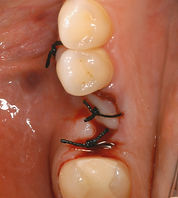
Dr Tim Lego
BDSc (HONS) Grad Dip Dental Sleep Medicine (UWA)
-
Snoring and Obstructive Sleep Apnoea
-
Sleep Bruxism and Temporomandibular Dysfunction
-
Interceptive Orthodontics
-
General Dental Care
"Member Australasian Sleep Association"
GENERAL DENTAL
Pain Control and Sedation
With access to modern local anaesthetics, analgesics, sedatives and or supportive inhalational sedation, your dentistry can now be delivered in a relaxed, comfortable and predictable setting.
Metal Free (Non-Amalgam) Dentistry
In the wake of mercury toxicity concerns, the demise of amalgam, rising gold costs and the desire for the perfect smile, patients are now afforded a wide range of metal free products and techniques to choose from. Although long-term clinical studies are not available for all materials, there is general consensus within the profession that when used according to standard protocols, the newer generation materials appear to be standing up well when compared against their traditional metal based counterparts.
Although we don’t use mercury based (amalgam) products, as non-metal derivatives are generally weaker, more technique sensitive and expensive, patients need to appreciate their indications and limitations within context of contemporary care. Whilst we do not recommend en-masse amalgam removal, patient specific protocols can be developed according to patient need and or as directed on medical grounds.
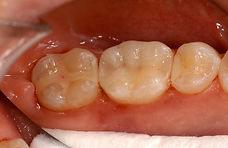
Periodontal (gum) and Preventative Care
Like tooth decay, periodontitis is bacterial specific and multifactorial in origin, the severity of which remains a complex interplay between tooth anatomy, oral hygiene and overall medical status.
Smoking, stress, mouth breathing, diabetes, occlusal overload and genetics have all been implicated in the pathogenesis of periodontal disease.
There is a growing body of evidence supporting sleep disordered breathing as a possible underlying cause which in part may help explain the common association between cardiovascular disease, type II diabetes and periodontitis.
Chronic bacterial colonization of supporting tissues results in irreversible destruction of the periodontal ligament that surrounds teeth, in turn signalling bone loss, pocketing and or recession of gingival tissues with resultant increased tooth mobility and potential tooth loss.
Other than occasional bleeding when brushing, the condition is often painless until terminal.
Depending on severity and relevant medical status, specialist periodontal management may be indicated on a 4-6 monthly basis, or if less severe, may be managed in house, often on a shared protocol.
Treatment is aimed at elimination or disruption of bacterial deposits on a regular basis both at home, and with the support of regular professional maintenance via scaling and root planing, oral hygiene instruction, mouthwashes and occasionally antibiotics.
The disease process is often progressive in nature, irreversible and a common cause of tooth loss.
Gingivitis represents the lesser variant being confined to the marginal soft tissues and is reversible assuming regular professional maintenance is supported by regular home care. Uncontrolled, gingivitis can progress into periodontitis.
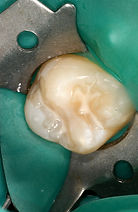
Minimal Intervention Dentistry
Minimal Intervention dentistry (MID) represents a more conservative approach to dental care, with management initially focused on addressing more advanced carious lesions whilst electing to monitor smaller non-cavitated lesions at regular prescribed intervals.
This implies underlying causative factors are controlled whilst recognising the potential for non-cavitated lesions to remineralize and arrest, thereby delaying or eliminating the need for invasive procedures which can further predispose to complication.
One must appreciate that teeth were never meant to be filled and the longer this process can be delayed, the better.
Tooth Whitening
Tooth whitening can be performed in a variety of ways, depending on cause of dental discoloration.
-
Non-vital bleaching – this applies to teeth that have been endodontically treated (root filled). Whilst not always predictable, a bleaching agent is placed within the tooth until such time that the desired result has been achieved. The tooth is accordingly restored.
-
Vital Bleaching – this applies to teeth that are often minimally restored and or discoloured due to causes other than root fillings. It can be performed in house using highly concentrated bleaching agents and or lasers, or more commonly at home with custom fabricated trays (stents) and less concentrated but often equally effective bleaching agents.
-
Microabrasion – this technique employs an acidic polishing paste in conjunction with vital bleaching and remineralization agents. It was primarily developed to assist in the management of hypoplastic and discoloured enamel that is commonly associated with developmental disturbances during formative years.
Unfortunately Bleaching is not predictable or permanent, with any improvement reverting to baseline after 12-18 months. Bleaching will not improve existing dental restorations, sometimes demanding replacement post bleaching. Sensitivity is not uncommon or long lasting and can be minimised by using the less concentrated at home techniques coupled with desensitising regimes.
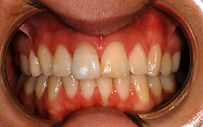
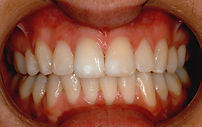
Dentistry for the Child and Adolescent
Paediatric dentistry refers to dentistry for the child and adolescent. It encompasses a broad range of treatments ranging from simple procedures including interceptive orthodontics to encourage normal arch development, to complex restoration of badly broken down dentitions often with the assistance of sedation and or specialist referral. Whilst patient age, demeanour and treatment needs will largely determine what care can be provided in a general clinical setting, we will always aim for a positive experience that one can build upon in years to come.
Caries Control (fluoride bombs)
Fluoride bombs are large areas of tooth decay (caries), often detected by chance radiographically, in the absence of clinical cavitation. Fluoride both strengthens and renders inorganic components of teeth (enamel) resistant to acid attack, acids typically produced by decay causing bacteria metabolizing refined carbohydrates (sugars). However, if fluoridated enamel is repeatedly stressed by the effects of sleep bruxism, microcracks can appear and propagate, literally opening the door for cariogenic bacteria to access the organic component of teeth (dentine) resulting in degradation (decay) and undermining of enamel, similar to traditional models. The difference being, teeth exposed to fluoride during formative years (with their hardened enamel) will not cavitate as early and the same stresses that cause the microcracks continue to fuel the spread of the carious lesion.
Conceivably therefore, whilst fluoridation may help prevent dental caries caused by acid attack, it may equally mask breakdown associated with crack attack. Any condition predisposing towards sleep bruxism may therefore contribute towards tooth decay, modelling that challenges traditionally held dietary and oral hygiene based theories.
Caries Control describes management of teeth with deepest decay first so as to help reduce risk of future endodontic complication.
It often represents an investigative approach, the dentist not knowing the true extent of decay until the tooth concerned is treated.
A decision can then be made as to the likely need for endodontic treatment, long term restorative requirements and or extraction.
Glass-ionomer is the material of choice, due to its inherent ability to seal well, release fluoride into surrounding tooth structure and minimise temperature conduction whilst affording time to monitor pulp status.
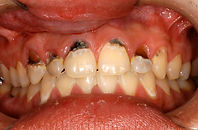

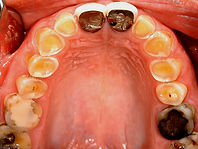
Dental Erosion (Corrosion)
Dental erosion (corrosion) is defined as chemical dissolution of teeth through non-bacterial processes, mediated through either endogenous (gastric) and or exogenous (dietary) acid which softens and weakens dental hard tissues and selectively favours decay causing (cariogenic) bacteria, resulting in aggravated wear rates, differential loading patterns and erosive caries (decay). When combined with the effects of dry mouth and bruxism, dental prognosis can be poor.
A common side effect of medications, alcohol, smoking, recreational drug use and or medical conditions themselves, patients with endogenous acidity are usually asymptomatic, the only signs being bad taste or breathe upon waking, film on the surface of the tongue, annoying non-productive cough, post nasal drip and or ptyalism (excessive salivation) during sleep.
Exogenous acidity produces a different pattern of dental wear and is frequently seen in patients who are vegetarian and or take dietary supplements.
Oral Surgery
Extraction of teeth is still recommended for a variety of reasons including extensive decay, nerve involvement, advanced gum (periodontal) disease, limited strategic value, potential to complicate overall treatment, orthodontic and or financial constraints. There is common misconception that one needs to retain a full complement of teeth to function and maintain oral and systemic health, with research in recent years supporting the notion of shortened (premolar to premolar) archforms over the traditional need to retain molars.
With experience, we appreciate what can be safely, comfortably and predictably performed in a general care setting as opposed to being more appropriately managed at specialist level with the benefit of a controlled setting.
